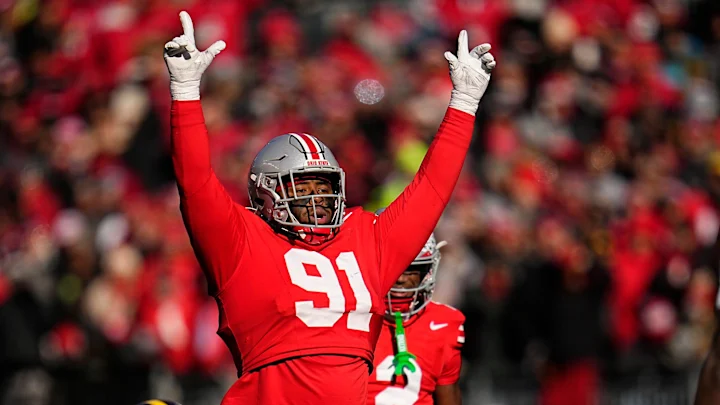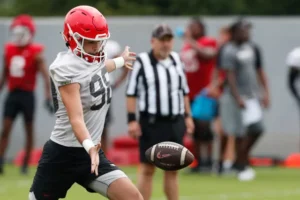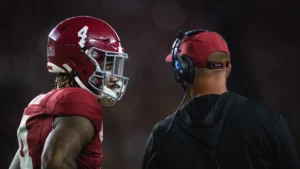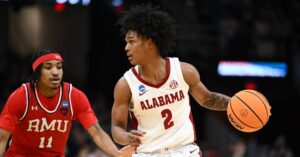
Brad Holmes Reveals Tyleik Williams as the Detroit Lions’ Primary Draft Focus
The air crackled with anticipation in the Detroit Lions’ draft room. General Manager Brad Holmes, a figure now synonymous with shrewd player evaluation and strategic maneuvering, sat at the helm, his gaze fixed intently on the unfolding draft board. Months of meticulous scouting, countless hours of film study, and a relentless pursuit of talent had culminated in this pivotal moment. While the Lions possessed a multitude of needs and a desire to bolster their already promising roster, Holmes later revealed a truth that underscored the organization’s conviction: Tyleik Williams, the formidable defensive tackle from Ohio State, was their “top target.”
The revelation, delivered with Holmes’ characteristic blend of candor and measured enthusiasm, offered a fascinating glimpse into the inner workings of the Lions’ draft strategy. It wasn’t merely a case of addressing a positional need; it was an unwavering belief in Williams’ potential to become a cornerstone of their defense for years to come. This singular focus, in a draft brimming with talent across various positions, spoke volumes about the impact Williams had made on the Lions’ scouting department.
Williams, a disruptive force along the interior defensive line, had long been on the Lions’ radar. His blend of size, athleticism, and raw power was precisely what the team sought to fortify their defensive front. At 6-foot-3 and weighing well over 300 pounds, Williams possessed the physical tools to command attention and disrupt opposing offenses. Yet, it was his agility and surprising quickness for his size that truly set him apart. He wasn’t just a space-eater; he was a penetrator, capable of collapsing the pocket and creating havoc in the backfield.
Throughout his career at Ohio State, Williams consistently showcased his ability to pressure quarterbacks and disrupt running lanes. His sophomore season saw him emerge as a dominant force, consistently grading out as one of the top interior defensive linemen in the nation. His ability to win one-on-one matchups, coupled with his relentless motor, made him a constant threat to opposing offenses. He possessed the versatility to play multiple techniques along the defensive line, further enhancing his value and appeal to NFL teams.
The Lions, under the guidance of Holmes and head coach Dan Campbell, had cultivated a distinct identity – a team built on toughness, resilience, and a relentless pursuit of excellence. Williams, with his physical playing style and evident passion for the game, seemed to embody those very qualities. He wasn’t just a talented player; he appeared to be the right kind of player to seamlessly integrate into the Lions’ burgeoning culture.
The draft itself is a complex and often unpredictable affair. Teams’ needs evolve, unexpected runs on certain positions occur, and the delicate dance of trading up or down can dramatically alter the landscape. For the Lions to have identified Williams as their “top target” suggested a level of conviction that transcended the typical draft calculus. It implied that they were willing to navigate the uncertainties of the draft, potentially even at the risk of missing out on other talented players, to secure his services.
This level of focus also highlighted the specific vision the Lions had for their defense. While they had made significant strides in recent seasons, the need for consistent interior pressure remained a key area for improvement. Adding a player of Williams’ caliber could potentially elevate their entire defensive unit, making them a more formidable opponent for both the run and the pass. His presence in the middle would undoubtedly command double teams, freeing up opportunities for the Lions’ edge rushers and linebackers to make plays.
The draft unfolded with its usual twists and turns. As the Lions’ turn approached, the tension in their draft room would have been palpable. The possibility of another team selecting Williams loomed large. The collective exhale that surely followed when his name was still on the board would have been a moment of significant relief and validation for Holmes and his staff.
Selecting Williams wasn’t just about filling a need; it was about adding a potential difference-maker. It was about investing in a player who possessed the rare combination of physical attributes and inherent talent to become a dominant force in the NFL. Holmes’ declaration that Williams was their “top target” underscored the profound belief the organization had in his ability to contribute immediately and develop into a long-term star.
The impact of such a focused approach extends beyond the individual player. It sends a clear message to the rest of the team, the fans, and the league about the Lions’ intentions. It demonstrates a commitment to building a championship-caliber defense, one that can consistently disrupt opposing offenses and control the line of scrimmage.
Furthermore, identifying a “top target” and successfully acquiring him speaks to the effectiveness of the Lions’ scouting process. It highlights the synergy between the coaching staff, who identify the specific traits they desire in a player, and the scouting department, who diligently evaluate prospects and pinpoint those who best fit the team’s vision.
The selection of Tyleik Williams as the Detroit Lions’ “top target” represents more than just a draft pick. It signifies a strategic conviction, a belief in a player’s potential to transform their defense, and a testament to the meticulous and focused approach of Brad Holmes and the Lions’ front office. As Williams embarks on his NFL journey in the Motor City, the weight of those expectations will undoubtedly be present, but the unwavering belief of the Lions’ brain trust suggests that he possesses the talent and character to not only meet those expectations but to potentially exceed them, solidifying his place as a cornerstone of their defense for years to come. The revelation by Holmes offers a compelling narrative, underscoring the deliberate and decisive actions that are shaping the Detroit Lions into a team on the rise.





